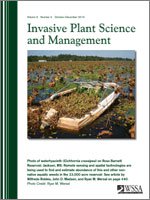The effect of invasive species might be lessened if herbivores reduced transpiration and growth rates; however, simply removing photosynthetic material might not ensure that the transpiration rate of active leaf tissue decreases. We assessed whether biological control has an injurious effect on the target plant species, giant reed (Arundo donax), by quantifying leaf photosynthetic and transpiration responses to two herbivores: an armored scale, Rhizaspidiotus donacis, and a stem-galling wasp, Tetramesa romana. Herbivory by a sap-feeding scale and a stem-galling wasp both separately and together, reduces the rates of leaf level physiological processes in A. donax. The effect of the wasp increases with density and reduces photosynthesis by reducing the carboxylation rate of ribulose-1,5-bisphosphate carboxylase oxygenase, which controls CO2 fixation in photosynthesis. The scale insect reduces photosynthesis by decreasing the maximum rate of electron transport, which determines how much light energy can be captured in photosynthesis. The effect of the armored scale takes approximately 5 mo after infestation, which coincides with generation time. When both insects are present at the same time, the effect of their herbivory appears additive after time for the scale to reproduce. We conclude that a combination of two herbivores can have a stronger physiological effect than one type of herbivore, likely because of their different effects on leaf function.
Nomenclature: Arundo scale, Rhizaspidiotus donacis Leonardi; Arundo wasp, Tetramesa romana Walker; Giant reed, Arundo donax L





